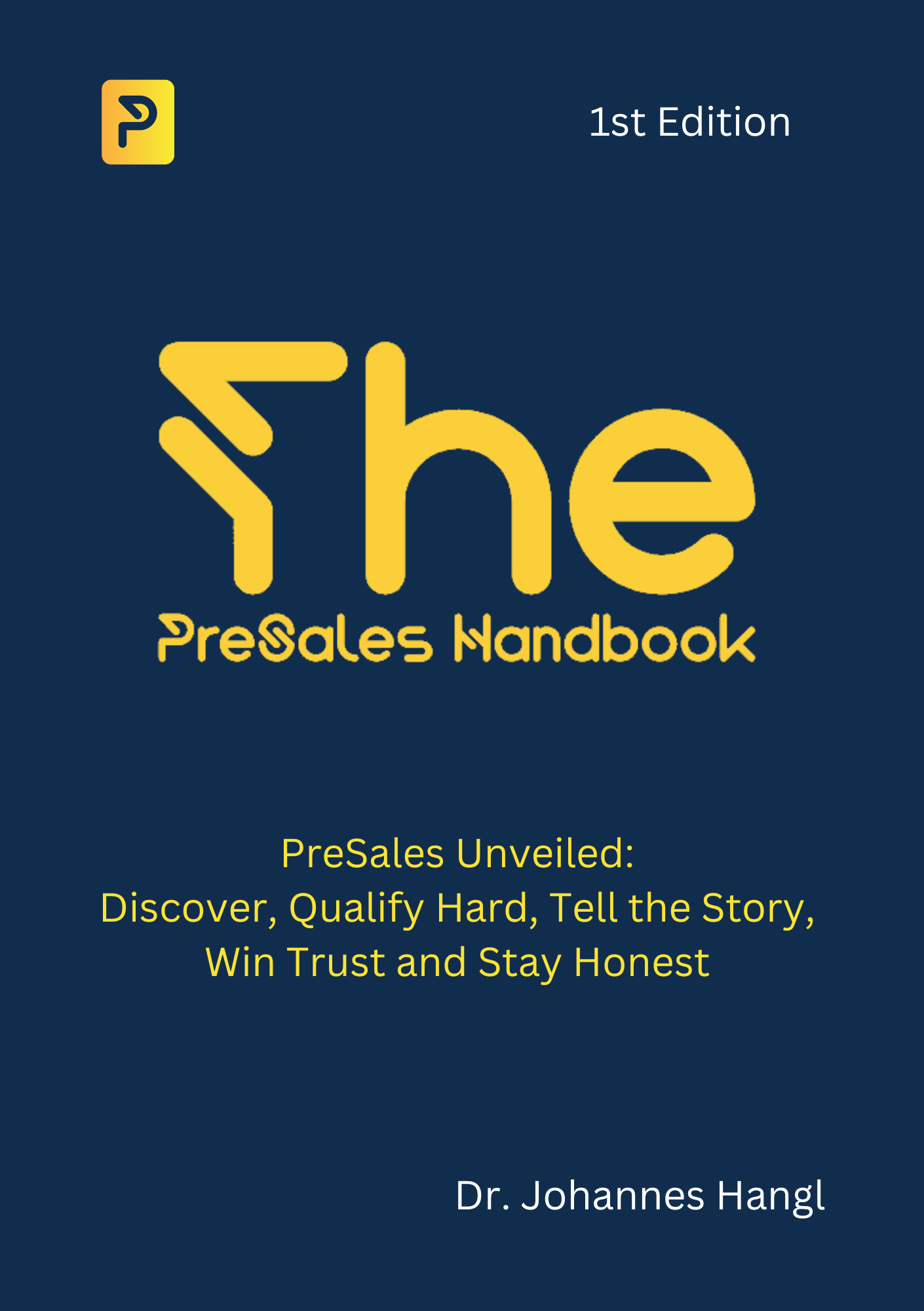High-level View of Buying Journey

| Awareness | Consideration | Decision | Purchase | Implementation | Post-Purchase | Retention & Renewal | Re-Evaluation |
|---|---|---|---|---|---|---|---|
| The buyer recognizes a need and the seller generates awareness about their offerings. | The buyer researches potential solutions and the seller positions their offering as a potential solution. | The buyer evaluates different options and the seller differentiates their offering | The buyer makes a buying decision and the seller facilitates the purchase process. | The company undergoes an onboarding process and integrates the software with other systems. | The buyer seeks to maximize value from the purchase and the seller offers post-sales support. | Vendors check in periodically and discuss renewals before the end of a subscription period. | The buyer´s needs evolve and they explore newer solutions in the market. |
120s Presales: Buying Journey
Awareness
Client: Recognises a need or problem but might not be able to articulate it explicitly.
Seller: Strives to generate awareness about your offerings, usually through marketing and outreach.
Problem/Need Recognition: Potential clients realise that they have a problem or need that can be addressed with a software solution.
Initial Research: You start looking for general information about solutions that could solve your identified problem.
Consideration
Client: Begins researching potential solutions to their identified problem.
Seller: Position their offering as a potential solution, often by providing educational content, webinars, or product demonstrations.
Evaluation of Options: Prospects explore different SaaS solutions and vendors that seem capable of addressing their needs.
Engagement: Prospects might interact with content, such as webinars, case studies, whitepapers, product demos, or client reviews, to understand the features and benefits of each solution.
Free Trial or Pilot: Many SaaS companies offer trials or pilot programs to let potential clients test out the products firsthand.
Decision
Client: Evaluates different options and nears a purchase decision.
Seller: Differentiates Seller’s offering, highlights unique value propositions, and addresses lingering concerns or objections.
Further Investigation: Prospects might require additional details, such as understanding integration, scalability, security features, and customisation capabilities.
Vendor Comparisons: Prospects compare shortlisted options based on pricing, features, client support, and user reviews.
Engagement with Sales: Prospects contact sales teams for personalised demos, pricing negotiations, and answers to specific questions.
Purchase Decision: The client finalises their decision and proceeds with the purchase, which might include formalities, such as contract signing and initial setup.
Purchase
Client: Makes a buying decision and completes the transaction.
Seller: Facilitates the purchase process, ensuring a smooth transition from prospect to client.
Implementation
Client: Clients actively participate in onboarding processes, providing access and necessary data for integration, while attending customized training sessions. They coordinate with their internal IT teams to ensure compatibility and assist in testing the integration
Seller: Sellers support the integration of software with existing tools and systems, manage data migration, configure software settings to meet specific needs, provide thorough training, and offer ongoing technical support to resolve any issues during setup and integration.
Onboarding: Once purchased, companies undergo an onboarding process that includes training sessions, data migration, and software setups.
Integration: Software may need to be integrated with other tools or systems that the company uses.
Post-Purchase
Client: Seeking to maximise value from the purchase may require support or additional resources.
Seller: Offers post-sales support, seeks feedback, and looks to nurture a relationship for potential upsells or referrals.
Adoption: Users within the organization begin using software in their daily operations.
Support: Companies may reach out for support queries, feature clarifications, or technical issues.
Feedback and Reviews: Some clients provide feedback, which can help vendors improve their products and services.
Expansion/Upsell: Over time, companies may decide to upgrade their plans, buy additional features, or expand their use to other departments.
Advocacy: Satisfied clients often become advocates, referring the software to peers or providing testimonials.
Retention & Renewal
Periodic Check-ins: Vendors might check in periodically to ensure everything is running smoothly and to address any concerns.
Renewal Discussions: Before the end of a subscription period, discussions on renewals, potential discounts, or contract changes take place.
Re-evaluation
Needs Change: Sometimes, as a company grows or its needs evolve, the current SaaS solution may no longer be adequate.
Market Exploration: Companies may look at newer solutions or updates in the market that better suit their evolved needs.
Buyer Personas
Understanding the buying personas is crucial for navigating the complex landscape of the buying process in SaaS businesses. Here’s a summary of each persona and strategies for engaging them throughout the buying process:
Finance: The Logical Powerhouse
Goal: Ensure the proposed solution aligns with the company’s financial goals.
Strategy: Present clear ROI, cost savings, and financial benefits early to gain their support.
Legal: The Bastion of Compliance
Goal: Ensure contracts and solutions comply with relevant laws and regulations.
Strategy: Engage early to address potential legal concerns and streamline the approval process.
IT Security: The Digital Sentinel
Goal: Protect the company from cybersecurity threats.
Strategy: Highlight security credentials and compliance certifications to build trust.
IT: The Integrators
Goal: Ensure the solution integrates seamlessly with existing technology.
Strategy: Demonstrate integration capabilities and share successful case studies.
Operations: The Pulse of Daily Function
Goal: Understand the impact of the solution on day-to-day operations.
Strategy: Offer demos and pilot programs to showcase practical benefits.
Purchasing: The Grand Negotiators
Goal: Negotiate the best terms and conditions for the company.
Strategy: Be transparent about pricing and flexible in terms and conditions.
The Member: Grounding the Discussion
Goal: Seek tangible benefits that improve daily tasks.
Strategy: Provide evidence of value through demonstrations and case studies.
The Sponsor: Appealing to Vision
Goal: Look for solutions that align with the company’s future goals.
Strategy: Use storytelling to paint a picture of long-term transformation.
The Champion: Fuelling the Flame
Goal: Advocate for your solution within the organization.
Strategy: Equip them with detailed information and data to support your solution.
The Detractor: Converting Scepticism into Support
Goal: Overcome their objections and earn their support.
Strategy: Engage in open dialogue to address concerns and provide evidence-based responses.
The Gatekeeper: Navigating the Labyrinth of Procedure
Goal: Ensure the acquisition aligns with company norms.
Strategy: Focus on compliance, protocols, and documentation to ease the process.
Selling Journey
The initial interaction between a seller and a potential buyer is crucial. This first conversation is an opportunity not only to make a strong first impression but also to set the stage for a mutually beneficial relationship. It is during this initial phase that sharing the company’s process becomes imperative.
Similarly, understanding the potential buyer’s purchasing process is equally crucial. This dual exchange of information ensures that both parties are aligned from the get-go. Such alignment is not just about avoiding miscommunications; it’s about crafting a path forward that respects the needs, constraints, and timelines of both the seller and the buyer.
Below, we delve into an example of a Selling Journey, illustrating how such exchanges might unfold and the impact they can have on the sales process. This journey underscores the importance of transparency, mutual understanding, and strategic alignment right from the first call. By adopting this approach, sales professionals can navigate the complex terrain of SaaS sales with greater confidence and success





